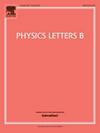Sphaleron freeze-in baryogenesis with gravitational waves from the QCD transition
IF 4.5
2区 物理与天体物理
Q1 ASTRONOMY & ASTROPHYSICS
引用次数: 0
Abstract
A large primordial lepton asymmetry can generate the observed baryon asymmetry of the Universe (BAU) through nonrestoration of electroweak symmetry at a high temperature, suppressing the sphaleron rate (“sphaleron freeze-in”). Such an asymmetry can lead to a first-order cosmic QCD transition with an observable gravitational wave (GW) signal. With next-to-leading order dimensional reduction and the exact 1-loop fluctuation determinant, we find the required lepton asymmetry to be an order of magnitude smaller than previous estimates. We apply a new and improved QCD equation of state reconciling the lattice and functional QCD results, to identify the range of lepton flavor asymmetries inducing a first-order cosmic QCD transition. Consistency with the observational constraints on the lepton asymmetries from the CMB and BBN requires an entropy dilution by a factor of for the correct BAU, while the first-order QCD transition can itself occur without the need for any entropy dilution. We show that the sphaleron freeze-in paradigm can potentially be probed by future GW experiments like Ares, if the bubble wall velocity of the QCD transition is large.
弹子在QCD跃迁引力波下的冻结重子形成
大的原始轻子不对称性可以通过在高温下电弱对称性的不恢复产生观测到的宇宙重子不对称性(BAU),从而抑制了闪子速率(“闪子冻结”)。这种不对称性可以导致一阶宇宙QCD跃迁,并伴有可观测到的引力波(GW)信号。通过次领先阶的降维和精确的1环波动行列式,我们发现所需的轻子不对称性比以前的估计要小一个数量级。我们应用一个新的改进的QCD状态方程来协调晶格和泛函QCD结果,以确定引起一阶宇宙QCD跃迁的轻子风味不对称的范围。与来自CMB和BBN的轻子不对称性的观测约束的一致性需要对正确的BAU进行0(10)倍的熵稀释,而一阶QCD跃迁本身可以发生而不需要任何熵稀释。我们表明,如果QCD跃迁的泡壁速度较大,则可以通过μAres等未来的GW实验来探索闪散子冻结范式。
本文章由计算机程序翻译,如有差异,请以英文原文为准。
求助全文
约1分钟内获得全文
求助全文
来源期刊

Physics Letters B
物理-物理:综合
CiteScore
9.10
自引率
6.80%
发文量
647
审稿时长
3 months
期刊介绍:
Physics Letters B ensures the rapid publication of important new results in particle physics, nuclear physics and cosmology. Specialized editors are responsible for contributions in experimental nuclear physics, theoretical nuclear physics, experimental high-energy physics, theoretical high-energy physics, and astrophysics.
 求助内容:
求助内容: 应助结果提醒方式:
应助结果提醒方式:


